BUSN20019 Report: Analysis of Lagging Agriculture Sector in Australia
VerifiedAdded on 2022/09/14
|13
|3117
|11
Report
AI Summary
This research proposal investigates the lagging performance of the agricultural industry in Australia compared to sectors like IT and mining. It aims to compare employment, wages, and income between agriculture and other industries, analyzing factors contributing to the sector's stagnation. The study employs data from the Australian Bureau of Statistics (ABS) and critical literature review, exploring drought impacts, salary disparities, and the role of technology and government strategies. Research questions focus on sales, niche markets, and the similarities between agriculture and IT. The methodology includes secondary data collection, exploratory investigative approach, and quantitative data analysis. The project's feasibility is assessed through a Gantt chart, highlighting the timeline for data gathering and analysis, ensuring completion within the specified timeframe. The report will examine the role of technology, government strategies, and market dynamics in the agriculture sector’s performance.
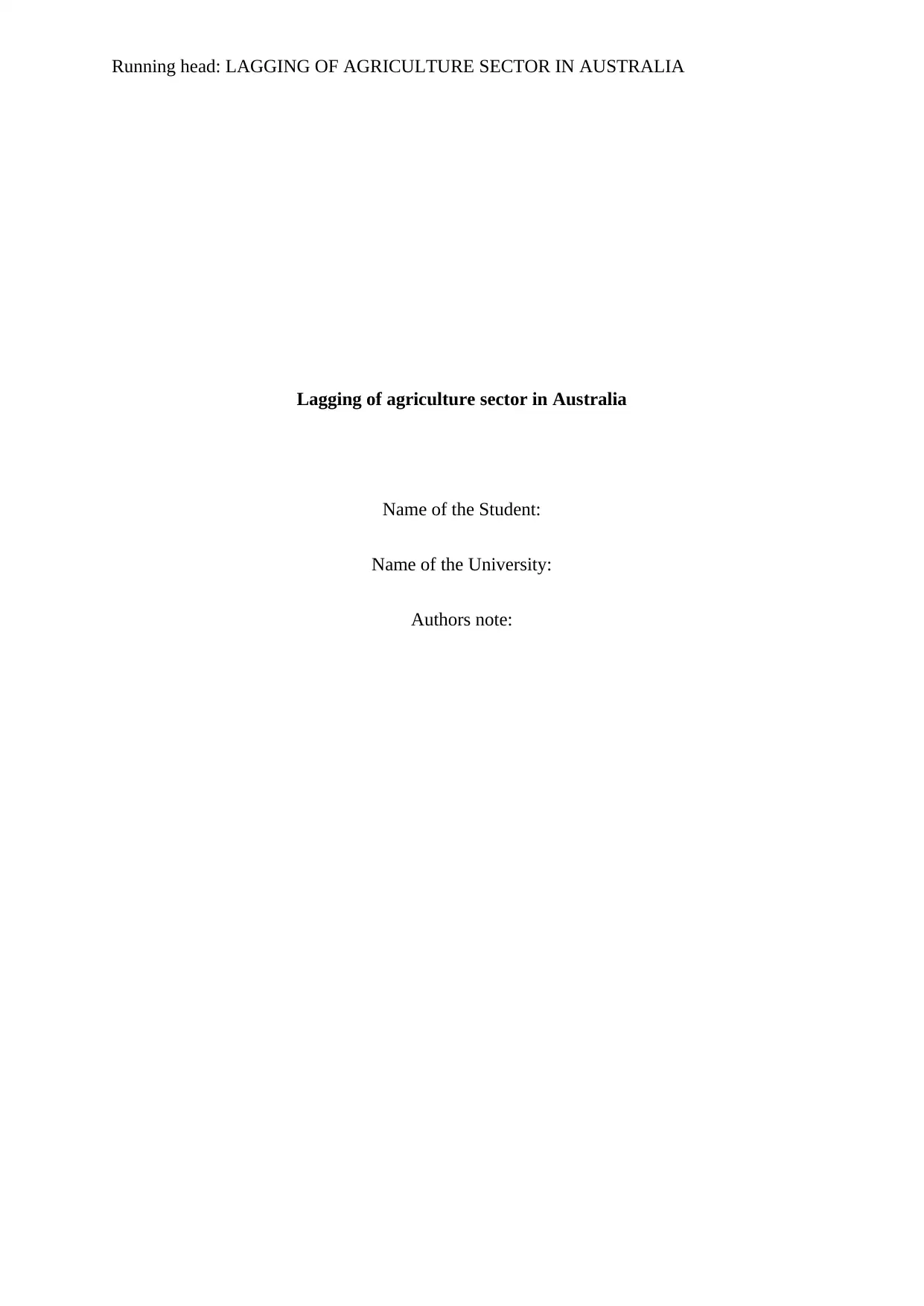
Running head: LAGGING OF AGRICULTURE SECTOR IN AUSTRALIA
Lagging of agriculture sector in Australia
Name of the Student:
Name of the University:
Authors note:
Lagging of agriculture sector in Australia
Name of the Student:
Name of the University:
Authors note:
Paraphrase This Document
Need a fresh take? Get an instant paraphrase of this document with our AI Paraphraser
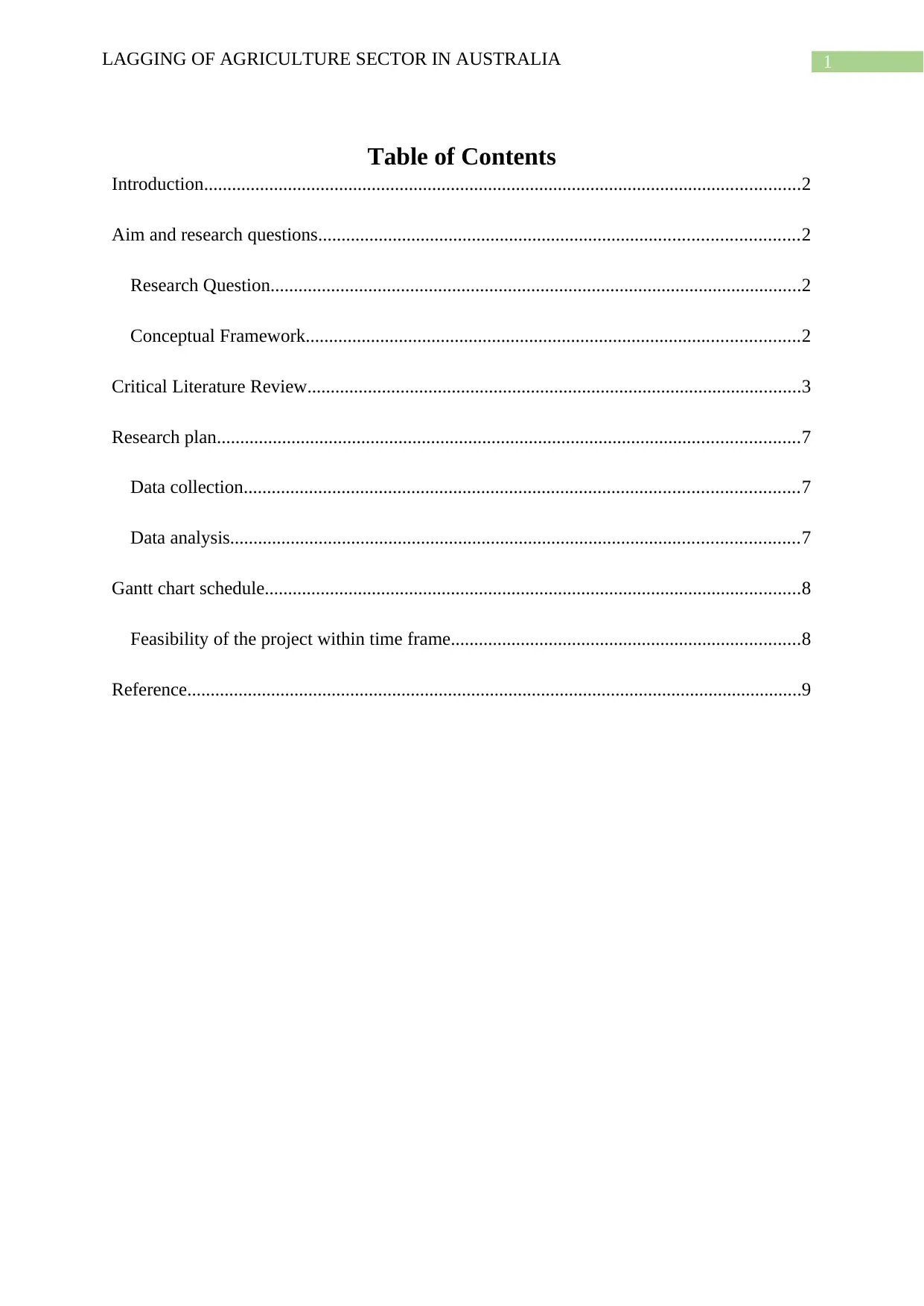
1LAGGING OF AGRICULTURE SECTOR IN AUSTRALIA
Table of Contents
Introduction................................................................................................................................2
Aim and research questions.......................................................................................................2
Research Question..................................................................................................................2
Conceptual Framework..........................................................................................................2
Critical Literature Review..........................................................................................................3
Research plan.............................................................................................................................7
Data collection.......................................................................................................................7
Data analysis..........................................................................................................................7
Gantt chart schedule...................................................................................................................8
Feasibility of the project within time frame...........................................................................8
Reference....................................................................................................................................9
Table of Contents
Introduction................................................................................................................................2
Aim and research questions.......................................................................................................2
Research Question..................................................................................................................2
Conceptual Framework..........................................................................................................2
Critical Literature Review..........................................................................................................3
Research plan.............................................................................................................................7
Data collection.......................................................................................................................7
Data analysis..........................................................................................................................7
Gantt chart schedule...................................................................................................................8
Feasibility of the project within time frame...........................................................................8
Reference....................................................................................................................................9
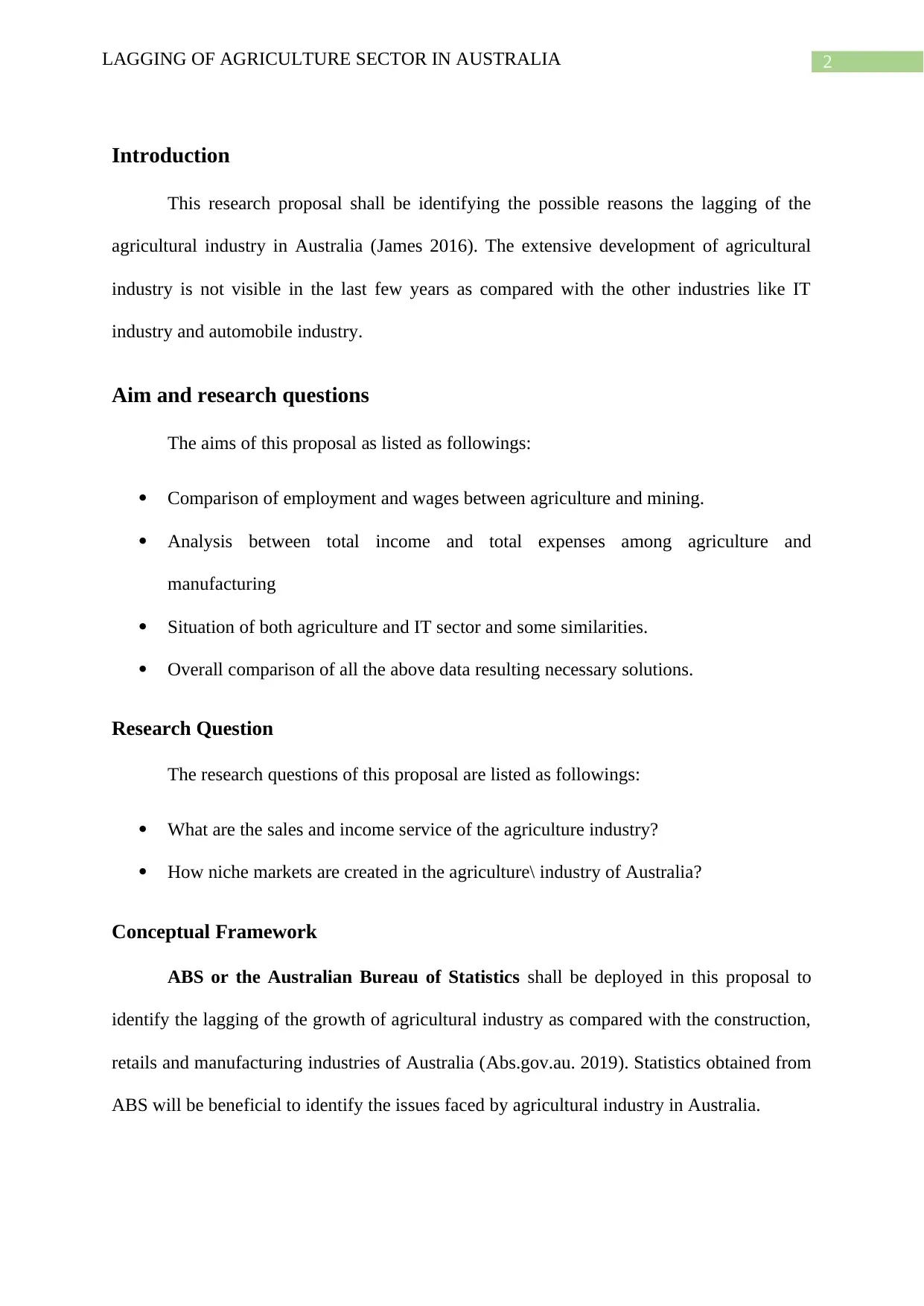
2LAGGING OF AGRICULTURE SECTOR IN AUSTRALIA
Introduction
This research proposal shall be identifying the possible reasons the lagging of the
agricultural industry in Australia (James 2016). The extensive development of agricultural
industry is not visible in the last few years as compared with the other industries like IT
industry and automobile industry.
Aim and research questions
The aims of this proposal as listed as followings:
Comparison of employment and wages between agriculture and mining.
Analysis between total income and total expenses among agriculture and
manufacturing
Situation of both agriculture and IT sector and some similarities.
Overall comparison of all the above data resulting necessary solutions.
Research Question
The research questions of this proposal are listed as followings:
What are the sales and income service of the agriculture industry?
How niche markets are created in the agriculture\ industry of Australia?
Conceptual Framework
ABS or the Australian Bureau of Statistics shall be deployed in this proposal to
identify the lagging of the growth of agricultural industry as compared with the construction,
retails and manufacturing industries of Australia (Abs.gov.au. 2019). Statistics obtained from
ABS will be beneficial to identify the issues faced by agricultural industry in Australia.
Introduction
This research proposal shall be identifying the possible reasons the lagging of the
agricultural industry in Australia (James 2016). The extensive development of agricultural
industry is not visible in the last few years as compared with the other industries like IT
industry and automobile industry.
Aim and research questions
The aims of this proposal as listed as followings:
Comparison of employment and wages between agriculture and mining.
Analysis between total income and total expenses among agriculture and
manufacturing
Situation of both agriculture and IT sector and some similarities.
Overall comparison of all the above data resulting necessary solutions.
Research Question
The research questions of this proposal are listed as followings:
What are the sales and income service of the agriculture industry?
How niche markets are created in the agriculture\ industry of Australia?
Conceptual Framework
ABS or the Australian Bureau of Statistics shall be deployed in this proposal to
identify the lagging of the growth of agricultural industry as compared with the construction,
retails and manufacturing industries of Australia (Abs.gov.au. 2019). Statistics obtained from
ABS will be beneficial to identify the issues faced by agricultural industry in Australia.
⊘ This is a preview!⊘
Do you want full access?
Subscribe today to unlock all pages.

Trusted by 1+ million students worldwide
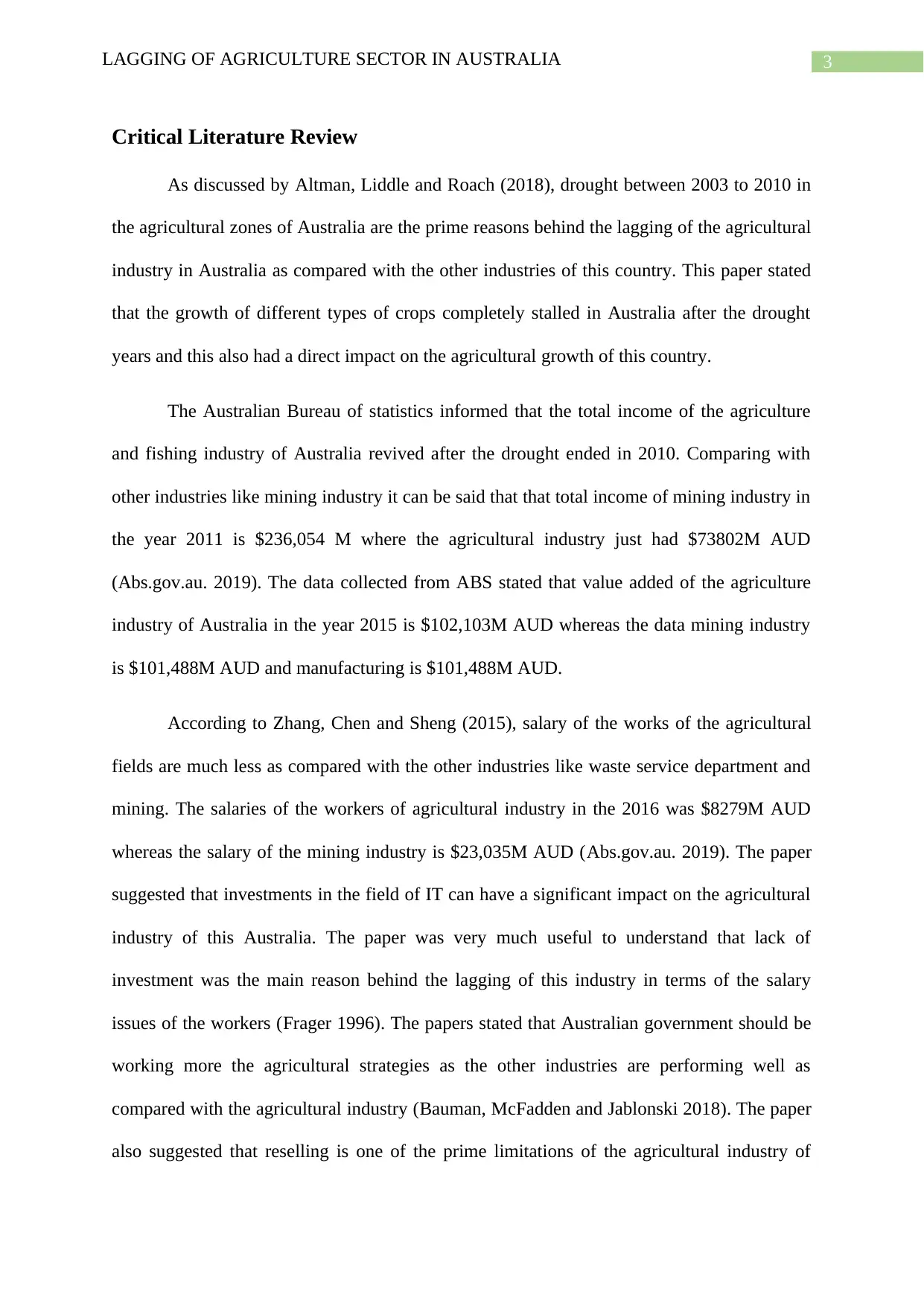
3LAGGING OF AGRICULTURE SECTOR IN AUSTRALIA
Critical Literature Review
As discussed by Altman, Liddle and Roach (2018), drought between 2003 to 2010 in
the agricultural zones of Australia are the prime reasons behind the lagging of the agricultural
industry in Australia as compared with the other industries of this country. This paper stated
that the growth of different types of crops completely stalled in Australia after the drought
years and this also had a direct impact on the agricultural growth of this country.
The Australian Bureau of statistics informed that the total income of the agriculture
and fishing industry of Australia revived after the drought ended in 2010. Comparing with
other industries like mining industry it can be said that that total income of mining industry in
the year 2011 is $236,054 M where the agricultural industry just had $73802M AUD
(Abs.gov.au. 2019). The data collected from ABS stated that value added of the agriculture
industry of Australia in the year 2015 is $102,103M AUD whereas the data mining industry
is $101,488M AUD and manufacturing is $101,488M AUD.
According to Zhang, Chen and Sheng (2015), salary of the works of the agricultural
fields are much less as compared with the other industries like waste service department and
mining. The salaries of the workers of agricultural industry in the 2016 was $8279M AUD
whereas the salary of the mining industry is $23,035M AUD (Abs.gov.au. 2019). The paper
suggested that investments in the field of IT can have a significant impact on the agricultural
industry of this Australia. The paper was very much useful to understand that lack of
investment was the main reason behind the lagging of this industry in terms of the salary
issues of the workers (Frager 1996). The papers stated that Australian government should be
working more the agricultural strategies as the other industries are performing well as
compared with the agricultural industry (Bauman, McFadden and Jablonski 2018). The paper
also suggested that reselling is one of the prime limitations of the agricultural industry of
Critical Literature Review
As discussed by Altman, Liddle and Roach (2018), drought between 2003 to 2010 in
the agricultural zones of Australia are the prime reasons behind the lagging of the agricultural
industry in Australia as compared with the other industries of this country. This paper stated
that the growth of different types of crops completely stalled in Australia after the drought
years and this also had a direct impact on the agricultural growth of this country.
The Australian Bureau of statistics informed that the total income of the agriculture
and fishing industry of Australia revived after the drought ended in 2010. Comparing with
other industries like mining industry it can be said that that total income of mining industry in
the year 2011 is $236,054 M where the agricultural industry just had $73802M AUD
(Abs.gov.au. 2019). The data collected from ABS stated that value added of the agriculture
industry of Australia in the year 2015 is $102,103M AUD whereas the data mining industry
is $101,488M AUD and manufacturing is $101,488M AUD.
According to Zhang, Chen and Sheng (2015), salary of the works of the agricultural
fields are much less as compared with the other industries like waste service department and
mining. The salaries of the workers of agricultural industry in the 2016 was $8279M AUD
whereas the salary of the mining industry is $23,035M AUD (Abs.gov.au. 2019). The paper
suggested that investments in the field of IT can have a significant impact on the agricultural
industry of this Australia. The paper was very much useful to understand that lack of
investment was the main reason behind the lagging of this industry in terms of the salary
issues of the workers (Frager 1996). The papers stated that Australian government should be
working more the agricultural strategies as the other industries are performing well as
compared with the agricultural industry (Bauman, McFadden and Jablonski 2018). The paper
also suggested that reselling is one of the prime limitations of the agricultural industry of
Paraphrase This Document
Need a fresh take? Get an instant paraphrase of this document with our AI Paraphraser
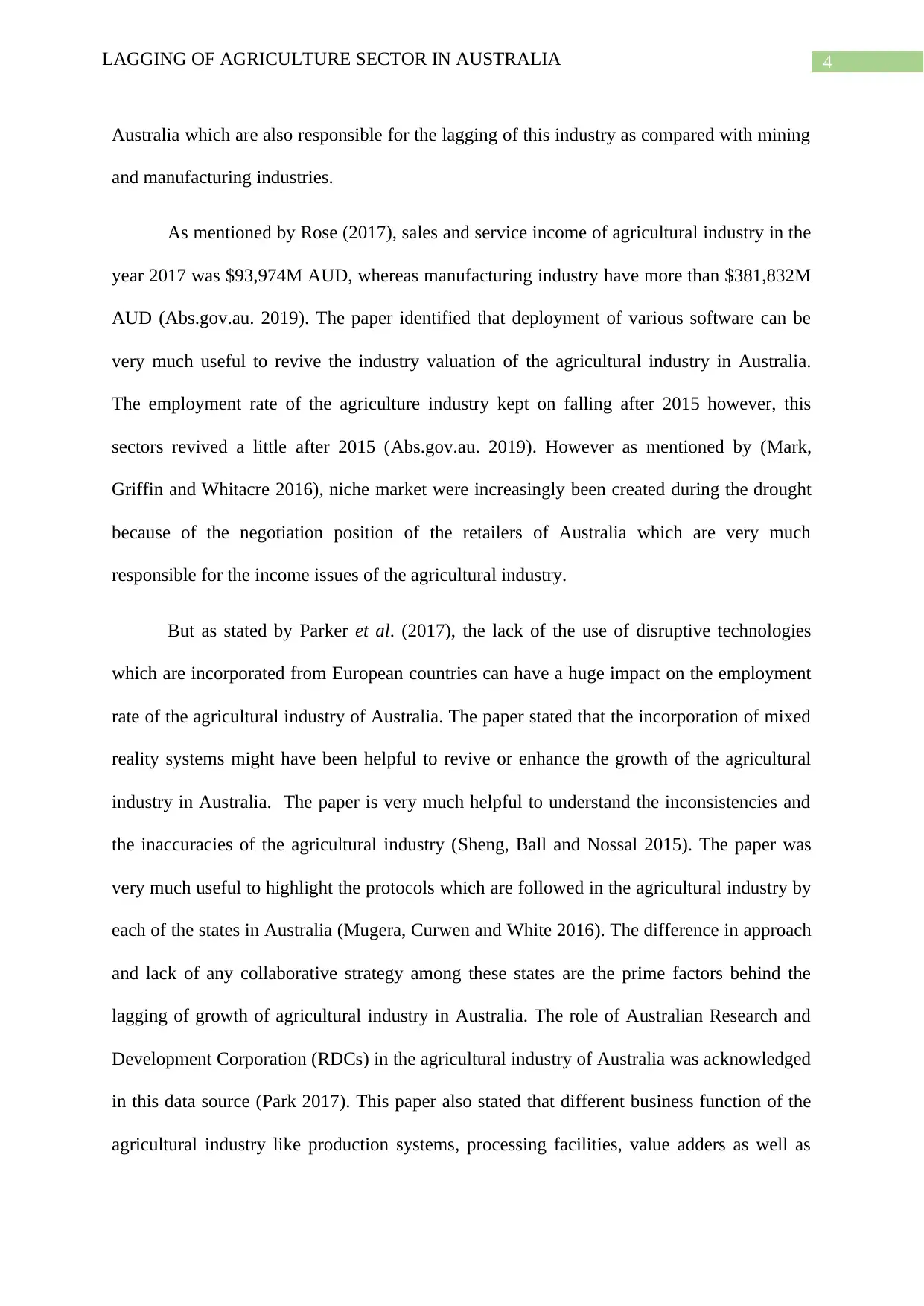
4LAGGING OF AGRICULTURE SECTOR IN AUSTRALIA
Australia which are also responsible for the lagging of this industry as compared with mining
and manufacturing industries.
As mentioned by Rose (2017), sales and service income of agricultural industry in the
year 2017 was $93,974M AUD, whereas manufacturing industry have more than $381,832M
AUD (Abs.gov.au. 2019). The paper identified that deployment of various software can be
very much useful to revive the industry valuation of the agricultural industry in Australia.
The employment rate of the agriculture industry kept on falling after 2015 however, this
sectors revived a little after 2015 (Abs.gov.au. 2019). However as mentioned by (Mark,
Griffin and Whitacre 2016), niche market were increasingly been created during the drought
because of the negotiation position of the retailers of Australia which are very much
responsible for the income issues of the agricultural industry.
But as stated by Parker et al. (2017), the lack of the use of disruptive technologies
which are incorporated from European countries can have a huge impact on the employment
rate of the agricultural industry of Australia. The paper stated that the incorporation of mixed
reality systems might have been helpful to revive or enhance the growth of the agricultural
industry in Australia. The paper is very much helpful to understand the inconsistencies and
the inaccuracies of the agricultural industry (Sheng, Ball and Nossal 2015). The paper was
very much useful to highlight the protocols which are followed in the agricultural industry by
each of the states in Australia (Mugera, Curwen and White 2016). The difference in approach
and lack of any collaborative strategy among these states are the prime factors behind the
lagging of growth of agricultural industry in Australia. The role of Australian Research and
Development Corporation (RDCs) in the agricultural industry of Australia was acknowledged
in this data source (Park 2017). This paper also stated that different business function of the
agricultural industry like production systems, processing facilities, value adders as well as
Australia which are also responsible for the lagging of this industry as compared with mining
and manufacturing industries.
As mentioned by Rose (2017), sales and service income of agricultural industry in the
year 2017 was $93,974M AUD, whereas manufacturing industry have more than $381,832M
AUD (Abs.gov.au. 2019). The paper identified that deployment of various software can be
very much useful to revive the industry valuation of the agricultural industry in Australia.
The employment rate of the agriculture industry kept on falling after 2015 however, this
sectors revived a little after 2015 (Abs.gov.au. 2019). However as mentioned by (Mark,
Griffin and Whitacre 2016), niche market were increasingly been created during the drought
because of the negotiation position of the retailers of Australia which are very much
responsible for the income issues of the agricultural industry.
But as stated by Parker et al. (2017), the lack of the use of disruptive technologies
which are incorporated from European countries can have a huge impact on the employment
rate of the agricultural industry of Australia. The paper stated that the incorporation of mixed
reality systems might have been helpful to revive or enhance the growth of the agricultural
industry in Australia. The paper is very much helpful to understand the inconsistencies and
the inaccuracies of the agricultural industry (Sheng, Ball and Nossal 2015). The paper was
very much useful to highlight the protocols which are followed in the agricultural industry by
each of the states in Australia (Mugera, Curwen and White 2016). The difference in approach
and lack of any collaborative strategy among these states are the prime factors behind the
lagging of growth of agricultural industry in Australia. The role of Australian Research and
Development Corporation (RDCs) in the agricultural industry of Australia was acknowledged
in this data source (Park 2017). This paper also stated that different business function of the
agricultural industry like production systems, processing facilities, value adders as well as
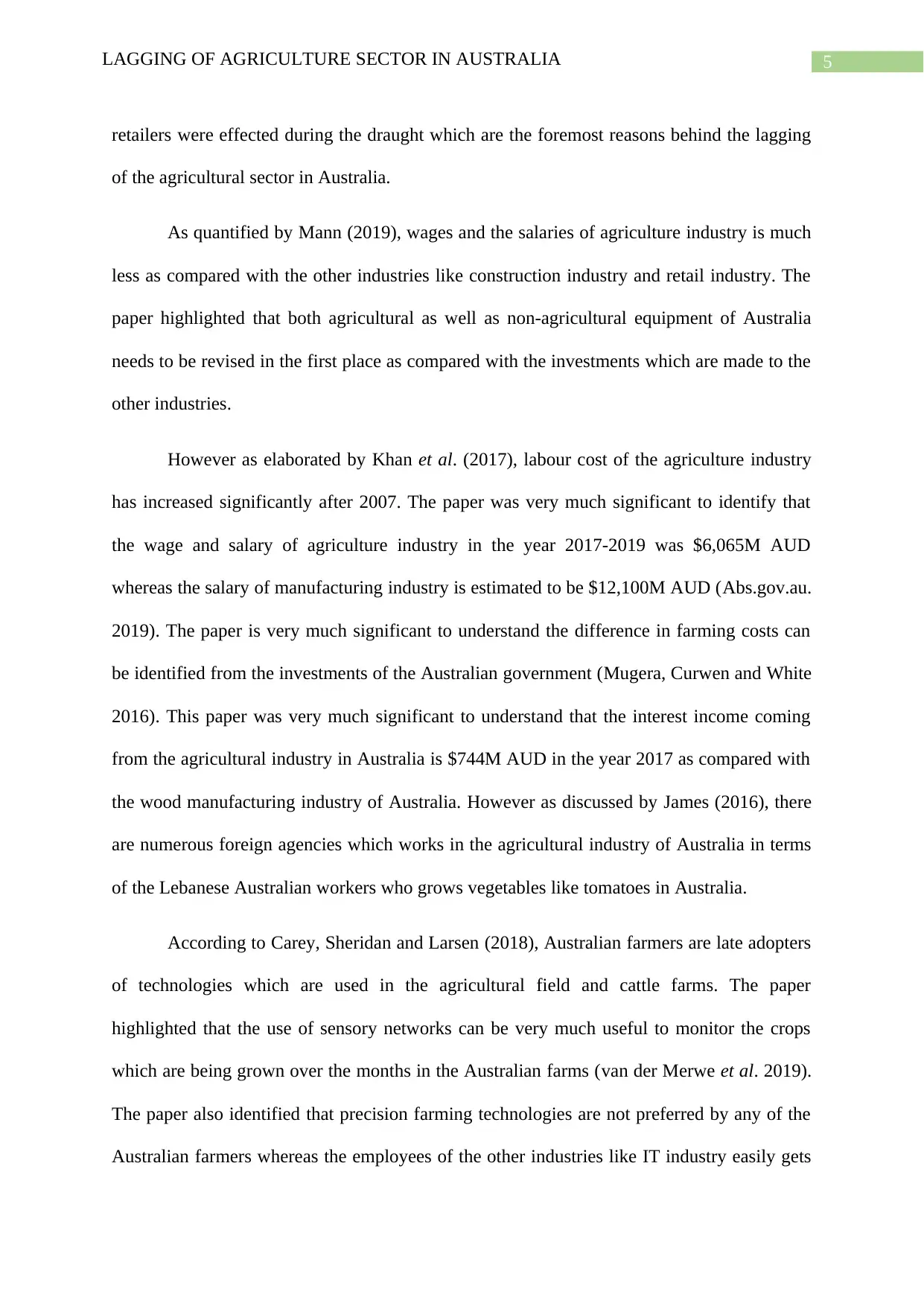
5LAGGING OF AGRICULTURE SECTOR IN AUSTRALIA
retailers were effected during the draught which are the foremost reasons behind the lagging
of the agricultural sector in Australia.
As quantified by Mann (2019), wages and the salaries of agriculture industry is much
less as compared with the other industries like construction industry and retail industry. The
paper highlighted that both agricultural as well as non-agricultural equipment of Australia
needs to be revised in the first place as compared with the investments which are made to the
other industries.
However as elaborated by Khan et al. (2017), labour cost of the agriculture industry
has increased significantly after 2007. The paper was very much significant to identify that
the wage and salary of agriculture industry in the year 2017-2019 was $6,065M AUD
whereas the salary of manufacturing industry is estimated to be $12,100M AUD (Abs.gov.au.
2019). The paper is very much significant to understand the difference in farming costs can
be identified from the investments of the Australian government (Mugera, Curwen and White
2016). This paper was very much significant to understand that the interest income coming
from the agricultural industry in Australia is $744M AUD in the year 2017 as compared with
the wood manufacturing industry of Australia. However as discussed by James (2016), there
are numerous foreign agencies which works in the agricultural industry of Australia in terms
of the Lebanese Australian workers who grows vegetables like tomatoes in Australia.
According to Carey, Sheridan and Larsen (2018), Australian farmers are late adopters
of technologies which are used in the agricultural field and cattle farms. The paper
highlighted that the use of sensory networks can be very much useful to monitor the crops
which are being grown over the months in the Australian farms (van der Merwe et al. 2019).
The paper also identified that precision farming technologies are not preferred by any of the
Australian farmers whereas the employees of the other industries like IT industry easily gets
retailers were effected during the draught which are the foremost reasons behind the lagging
of the agricultural sector in Australia.
As quantified by Mann (2019), wages and the salaries of agriculture industry is much
less as compared with the other industries like construction industry and retail industry. The
paper highlighted that both agricultural as well as non-agricultural equipment of Australia
needs to be revised in the first place as compared with the investments which are made to the
other industries.
However as elaborated by Khan et al. (2017), labour cost of the agriculture industry
has increased significantly after 2007. The paper was very much significant to identify that
the wage and salary of agriculture industry in the year 2017-2019 was $6,065M AUD
whereas the salary of manufacturing industry is estimated to be $12,100M AUD (Abs.gov.au.
2019). The paper is very much significant to understand the difference in farming costs can
be identified from the investments of the Australian government (Mugera, Curwen and White
2016). This paper was very much significant to understand that the interest income coming
from the agricultural industry in Australia is $744M AUD in the year 2017 as compared with
the wood manufacturing industry of Australia. However as discussed by James (2016), there
are numerous foreign agencies which works in the agricultural industry of Australia in terms
of the Lebanese Australian workers who grows vegetables like tomatoes in Australia.
According to Carey, Sheridan and Larsen (2018), Australian farmers are late adopters
of technologies which are used in the agricultural field and cattle farms. The paper
highlighted that the use of sensory networks can be very much useful to monitor the crops
which are being grown over the months in the Australian farms (van der Merwe et al. 2019).
The paper also identified that precision farming technologies are not preferred by any of the
Australian farmers whereas the employees of the other industries like IT industry easily gets
⊘ This is a preview!⊘
Do you want full access?
Subscribe today to unlock all pages.

Trusted by 1+ million students worldwide
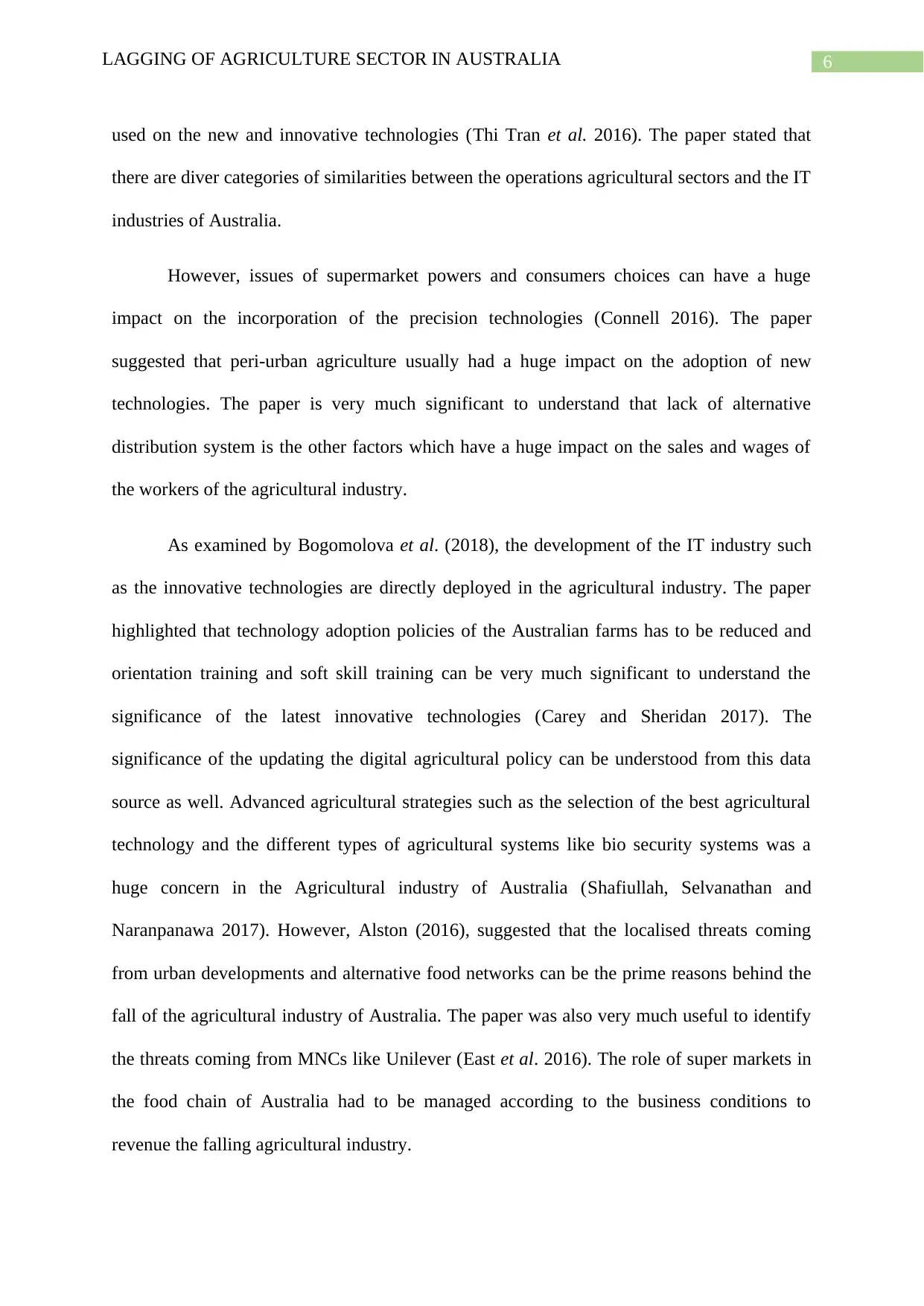
6LAGGING OF AGRICULTURE SECTOR IN AUSTRALIA
used on the new and innovative technologies (Thi Tran et al. 2016). The paper stated that
there are diver categories of similarities between the operations agricultural sectors and the IT
industries of Australia.
However, issues of supermarket powers and consumers choices can have a huge
impact on the incorporation of the precision technologies (Connell 2016). The paper
suggested that peri-urban agriculture usually had a huge impact on the adoption of new
technologies. The paper is very much significant to understand that lack of alternative
distribution system is the other factors which have a huge impact on the sales and wages of
the workers of the agricultural industry.
As examined by Bogomolova et al. (2018), the development of the IT industry such
as the innovative technologies are directly deployed in the agricultural industry. The paper
highlighted that technology adoption policies of the Australian farms has to be reduced and
orientation training and soft skill training can be very much significant to understand the
significance of the latest innovative technologies (Carey and Sheridan 2017). The
significance of the updating the digital agricultural policy can be understood from this data
source as well. Advanced agricultural strategies such as the selection of the best agricultural
technology and the different types of agricultural systems like bio security systems was a
huge concern in the Agricultural industry of Australia (Shafiullah, Selvanathan and
Naranpanawa 2017). However, Alston (2016), suggested that the localised threats coming
from urban developments and alternative food networks can be the prime reasons behind the
fall of the agricultural industry of Australia. The paper was also very much useful to identify
the threats coming from MNCs like Unilever (East et al. 2016). The role of super markets in
the food chain of Australia had to be managed according to the business conditions to
revenue the falling agricultural industry.
used on the new and innovative technologies (Thi Tran et al. 2016). The paper stated that
there are diver categories of similarities between the operations agricultural sectors and the IT
industries of Australia.
However, issues of supermarket powers and consumers choices can have a huge
impact on the incorporation of the precision technologies (Connell 2016). The paper
suggested that peri-urban agriculture usually had a huge impact on the adoption of new
technologies. The paper is very much significant to understand that lack of alternative
distribution system is the other factors which have a huge impact on the sales and wages of
the workers of the agricultural industry.
As examined by Bogomolova et al. (2018), the development of the IT industry such
as the innovative technologies are directly deployed in the agricultural industry. The paper
highlighted that technology adoption policies of the Australian farms has to be reduced and
orientation training and soft skill training can be very much significant to understand the
significance of the latest innovative technologies (Carey and Sheridan 2017). The
significance of the updating the digital agricultural policy can be understood from this data
source as well. Advanced agricultural strategies such as the selection of the best agricultural
technology and the different types of agricultural systems like bio security systems was a
huge concern in the Agricultural industry of Australia (Shafiullah, Selvanathan and
Naranpanawa 2017). However, Alston (2016), suggested that the localised threats coming
from urban developments and alternative food networks can be the prime reasons behind the
fall of the agricultural industry of Australia. The paper was also very much useful to identify
the threats coming from MNCs like Unilever (East et al. 2016). The role of super markets in
the food chain of Australia had to be managed according to the business conditions to
revenue the falling agricultural industry.
Paraphrase This Document
Need a fresh take? Get an instant paraphrase of this document with our AI Paraphraser
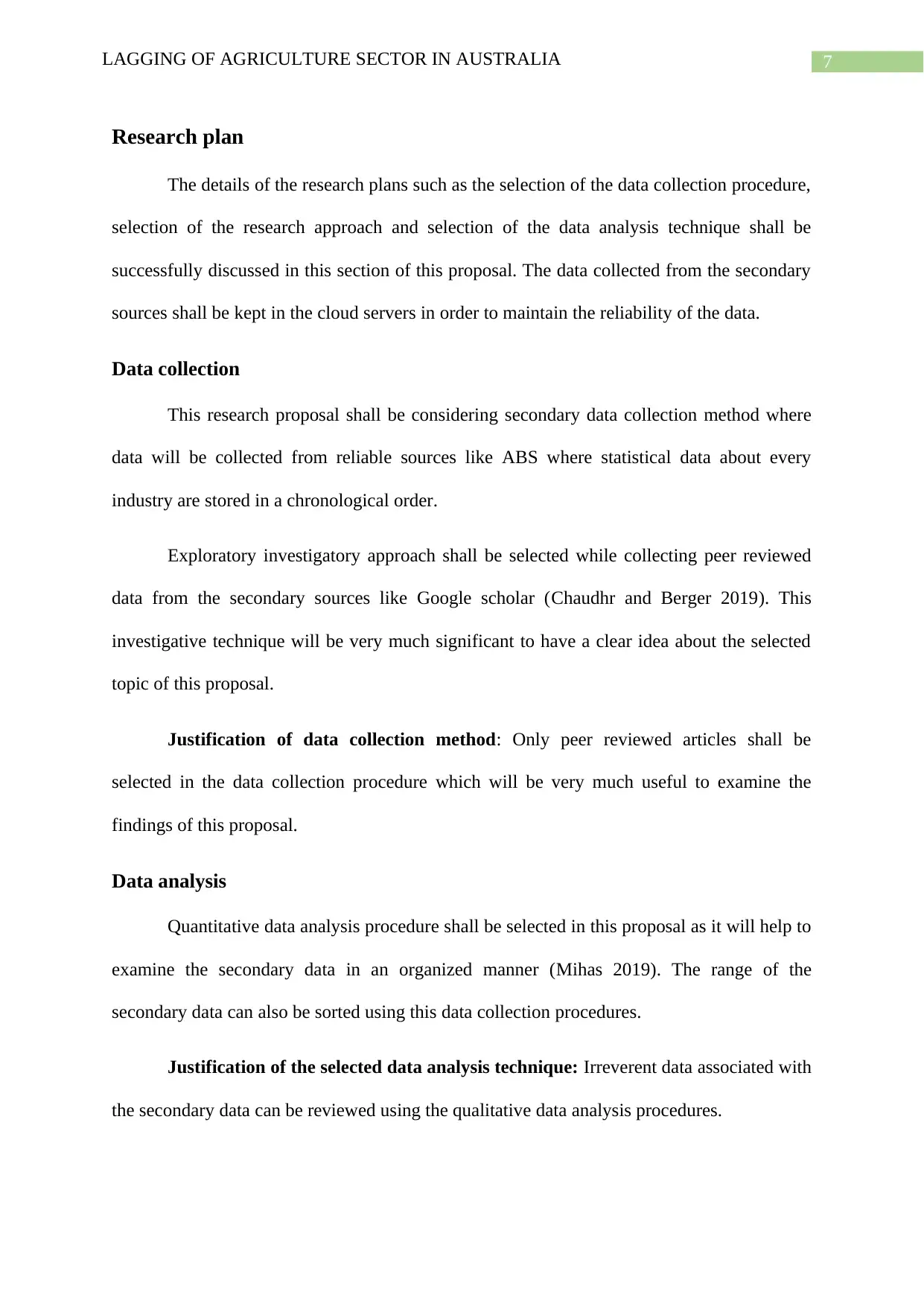
7LAGGING OF AGRICULTURE SECTOR IN AUSTRALIA
Research plan
The details of the research plans such as the selection of the data collection procedure,
selection of the research approach and selection of the data analysis technique shall be
successfully discussed in this section of this proposal. The data collected from the secondary
sources shall be kept in the cloud servers in order to maintain the reliability of the data.
Data collection
This research proposal shall be considering secondary data collection method where
data will be collected from reliable sources like ABS where statistical data about every
industry are stored in a chronological order.
Exploratory investigatory approach shall be selected while collecting peer reviewed
data from the secondary sources like Google scholar (Chaudhr and Berger 2019). This
investigative technique will be very much significant to have a clear idea about the selected
topic of this proposal.
Justification of data collection method: Only peer reviewed articles shall be
selected in the data collection procedure which will be very much useful to examine the
findings of this proposal.
Data analysis
Quantitative data analysis procedure shall be selected in this proposal as it will help to
examine the secondary data in an organized manner (Mihas 2019). The range of the
secondary data can also be sorted using this data collection procedures.
Justification of the selected data analysis technique: Irreverent data associated with
the secondary data can be reviewed using the qualitative data analysis procedures.
Research plan
The details of the research plans such as the selection of the data collection procedure,
selection of the research approach and selection of the data analysis technique shall be
successfully discussed in this section of this proposal. The data collected from the secondary
sources shall be kept in the cloud servers in order to maintain the reliability of the data.
Data collection
This research proposal shall be considering secondary data collection method where
data will be collected from reliable sources like ABS where statistical data about every
industry are stored in a chronological order.
Exploratory investigatory approach shall be selected while collecting peer reviewed
data from the secondary sources like Google scholar (Chaudhr and Berger 2019). This
investigative technique will be very much significant to have a clear idea about the selected
topic of this proposal.
Justification of data collection method: Only peer reviewed articles shall be
selected in the data collection procedure which will be very much useful to examine the
findings of this proposal.
Data analysis
Quantitative data analysis procedure shall be selected in this proposal as it will help to
examine the secondary data in an organized manner (Mihas 2019). The range of the
secondary data can also be sorted using this data collection procedures.
Justification of the selected data analysis technique: Irreverent data associated with
the secondary data can be reviewed using the qualitative data analysis procedures.
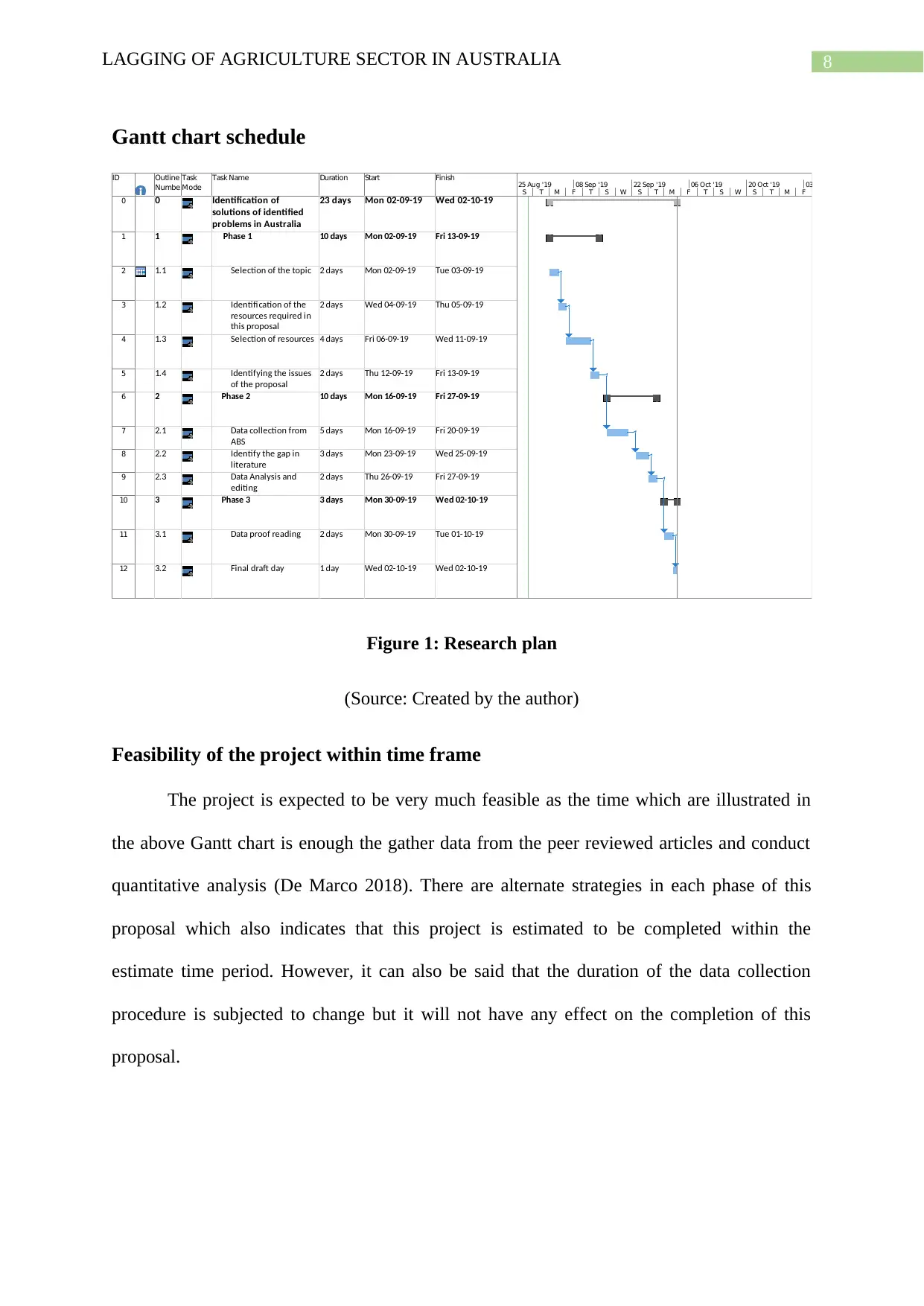
8LAGGING OF AGRICULTURE SECTOR IN AUSTRALIA
Gantt chart schedule
ID Outline
Number
Task
Mode
Task Name Duration Start Finish
0 0 Identification of
solutions of identified
problems in Australia
23 days Mon 02-09-19 Wed 02-10-19
1 1 Phase 1 10 days Mon 02-09-19 Fri 13-09-19
2 1.1 Selection of the topic 2 days Mon 02-09-19 Tue 03-09-19
3 1.2 Identification of the
resources required in
this proposal
2 days Wed 04-09-19 Thu 05-09-19
4 1.3 Selection of resources 4 days Fri 06-09-19 Wed 11-09-19
5 1.4 Identifying the issues
of the proposal
2 days Thu 12-09-19 Fri 13-09-19
6 2 Phase 2 10 days Mon 16-09-19 Fri 27-09-19
7 2.1 Data collection from
ABS
5 days Mon 16-09-19 Fri 20-09-19
8 2.2 Identify the gap in
literature
3 days Mon 23-09-19 Wed 25-09-19
9 2.3 Data Analysis and
editing
2 days Thu 26-09-19 Fri 27-09-19
10 3 Phase 3 3 days Mon 30-09-19 Wed 02-10-19
11 3.1 Data proof reading 2 days Mon 30-09-19 Tue 01-10-19
12 3.2 Final draft day 1 day Wed 02-10-19 Wed 02-10-19
S T M F T S W S T M F T S W S T M F
25 Aug '19 08 Sep '19 22 Sep '19 06 Oct '19 20 Oct '19 03 Nov '19
Figure 1: Research plan
(Source: Created by the author)
Feasibility of the project within time frame
The project is expected to be very much feasible as the time which are illustrated in
the above Gantt chart is enough the gather data from the peer reviewed articles and conduct
quantitative analysis (De Marco 2018). There are alternate strategies in each phase of this
proposal which also indicates that this project is estimated to be completed within the
estimate time period. However, it can also be said that the duration of the data collection
procedure is subjected to change but it will not have any effect on the completion of this
proposal.
Gantt chart schedule
ID Outline
Number
Task
Mode
Task Name Duration Start Finish
0 0 Identification of
solutions of identified
problems in Australia
23 days Mon 02-09-19 Wed 02-10-19
1 1 Phase 1 10 days Mon 02-09-19 Fri 13-09-19
2 1.1 Selection of the topic 2 days Mon 02-09-19 Tue 03-09-19
3 1.2 Identification of the
resources required in
this proposal
2 days Wed 04-09-19 Thu 05-09-19
4 1.3 Selection of resources 4 days Fri 06-09-19 Wed 11-09-19
5 1.4 Identifying the issues
of the proposal
2 days Thu 12-09-19 Fri 13-09-19
6 2 Phase 2 10 days Mon 16-09-19 Fri 27-09-19
7 2.1 Data collection from
ABS
5 days Mon 16-09-19 Fri 20-09-19
8 2.2 Identify the gap in
literature
3 days Mon 23-09-19 Wed 25-09-19
9 2.3 Data Analysis and
editing
2 days Thu 26-09-19 Fri 27-09-19
10 3 Phase 3 3 days Mon 30-09-19 Wed 02-10-19
11 3.1 Data proof reading 2 days Mon 30-09-19 Tue 01-10-19
12 3.2 Final draft day 1 day Wed 02-10-19 Wed 02-10-19
S T M F T S W S T M F T S W S T M F
25 Aug '19 08 Sep '19 22 Sep '19 06 Oct '19 20 Oct '19 03 Nov '19
Figure 1: Research plan
(Source: Created by the author)
Feasibility of the project within time frame
The project is expected to be very much feasible as the time which are illustrated in
the above Gantt chart is enough the gather data from the peer reviewed articles and conduct
quantitative analysis (De Marco 2018). There are alternate strategies in each phase of this
proposal which also indicates that this project is estimated to be completed within the
estimate time period. However, it can also be said that the duration of the data collection
procedure is subjected to change but it will not have any effect on the completion of this
proposal.
⊘ This is a preview!⊘
Do you want full access?
Subscribe today to unlock all pages.

Trusted by 1+ million students worldwide
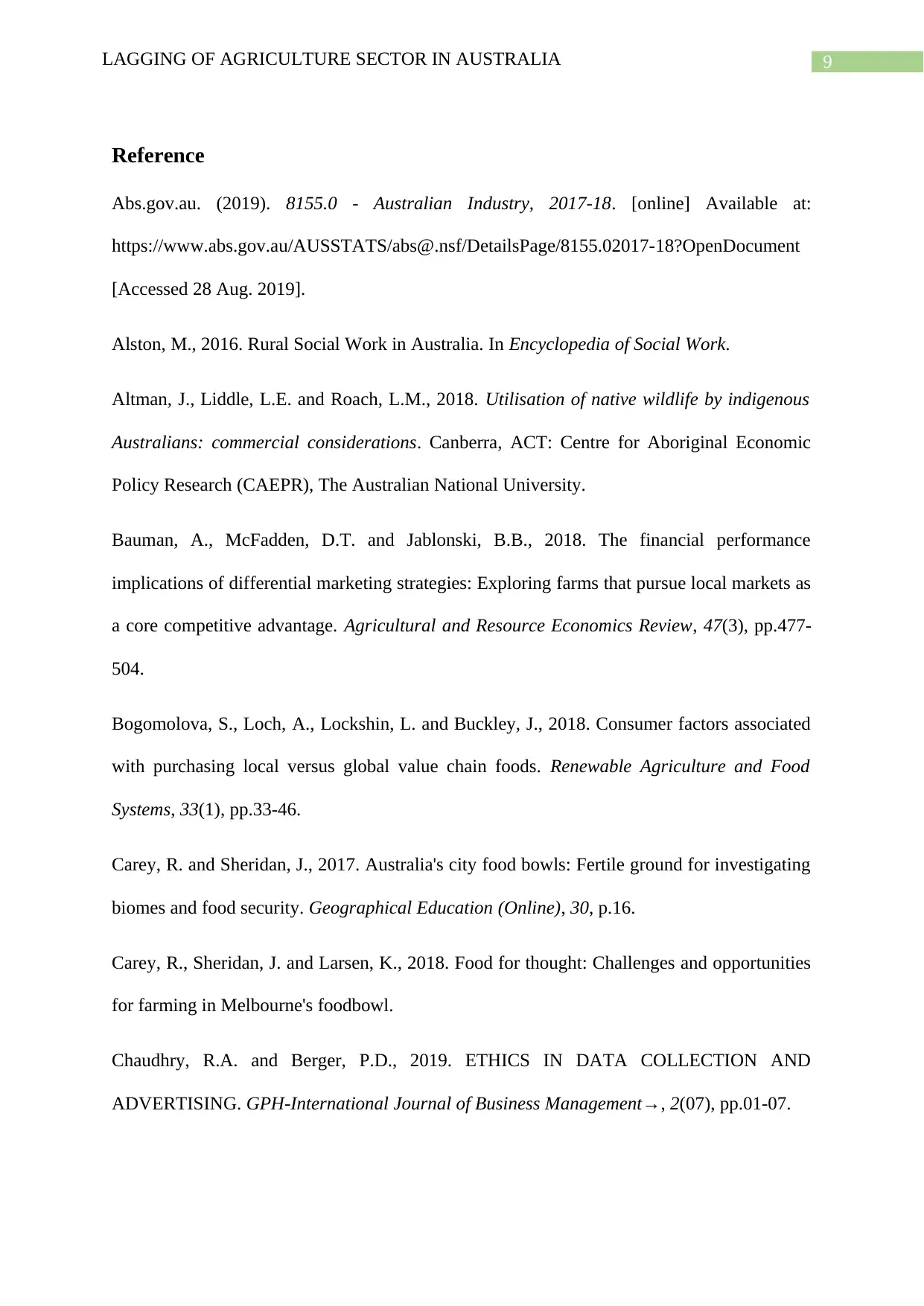
9LAGGING OF AGRICULTURE SECTOR IN AUSTRALIA
Reference
Abs.gov.au. (2019). 8155.0 - Australian Industry, 2017-18. [online] Available at:
https://www.abs.gov.au/AUSSTATS/abs@.nsf/DetailsPage/8155.02017-18?OpenDocument
[Accessed 28 Aug. 2019].
Alston, M., 2016. Rural Social Work in Australia. In Encyclopedia of Social Work.
Altman, J., Liddle, L.E. and Roach, L.M., 2018. Utilisation of native wildlife by indigenous
Australians: commercial considerations. Canberra, ACT: Centre for Aboriginal Economic
Policy Research (CAEPR), The Australian National University.
Bauman, A., McFadden, D.T. and Jablonski, B.B., 2018. The financial performance
implications of differential marketing strategies: Exploring farms that pursue local markets as
a core competitive advantage. Agricultural and Resource Economics Review, 47(3), pp.477-
504.
Bogomolova, S., Loch, A., Lockshin, L. and Buckley, J., 2018. Consumer factors associated
with purchasing local versus global value chain foods. Renewable Agriculture and Food
Systems, 33(1), pp.33-46.
Carey, R. and Sheridan, J., 2017. Australia's city food bowls: Fertile ground for investigating
biomes and food security. Geographical Education (Online), 30, p.16.
Carey, R., Sheridan, J. and Larsen, K., 2018. Food for thought: Challenges and opportunities
for farming in Melbourne's foodbowl.
Chaudhry, R.A. and Berger, P.D., 2019. ETHICS IN DATA COLLECTION AND
ADVERTISING. GPH-International Journal of Business Management→, 2(07), pp.01-07.
Reference
Abs.gov.au. (2019). 8155.0 - Australian Industry, 2017-18. [online] Available at:
https://www.abs.gov.au/AUSSTATS/abs@.nsf/DetailsPage/8155.02017-18?OpenDocument
[Accessed 28 Aug. 2019].
Alston, M., 2016. Rural Social Work in Australia. In Encyclopedia of Social Work.
Altman, J., Liddle, L.E. and Roach, L.M., 2018. Utilisation of native wildlife by indigenous
Australians: commercial considerations. Canberra, ACT: Centre for Aboriginal Economic
Policy Research (CAEPR), The Australian National University.
Bauman, A., McFadden, D.T. and Jablonski, B.B., 2018. The financial performance
implications of differential marketing strategies: Exploring farms that pursue local markets as
a core competitive advantage. Agricultural and Resource Economics Review, 47(3), pp.477-
504.
Bogomolova, S., Loch, A., Lockshin, L. and Buckley, J., 2018. Consumer factors associated
with purchasing local versus global value chain foods. Renewable Agriculture and Food
Systems, 33(1), pp.33-46.
Carey, R. and Sheridan, J., 2017. Australia's city food bowls: Fertile ground for investigating
biomes and food security. Geographical Education (Online), 30, p.16.
Carey, R., Sheridan, J. and Larsen, K., 2018. Food for thought: Challenges and opportunities
for farming in Melbourne's foodbowl.
Chaudhry, R.A. and Berger, P.D., 2019. ETHICS IN DATA COLLECTION AND
ADVERTISING. GPH-International Journal of Business Management→, 2(07), pp.01-07.
Paraphrase This Document
Need a fresh take? Get an instant paraphrase of this document with our AI Paraphraser
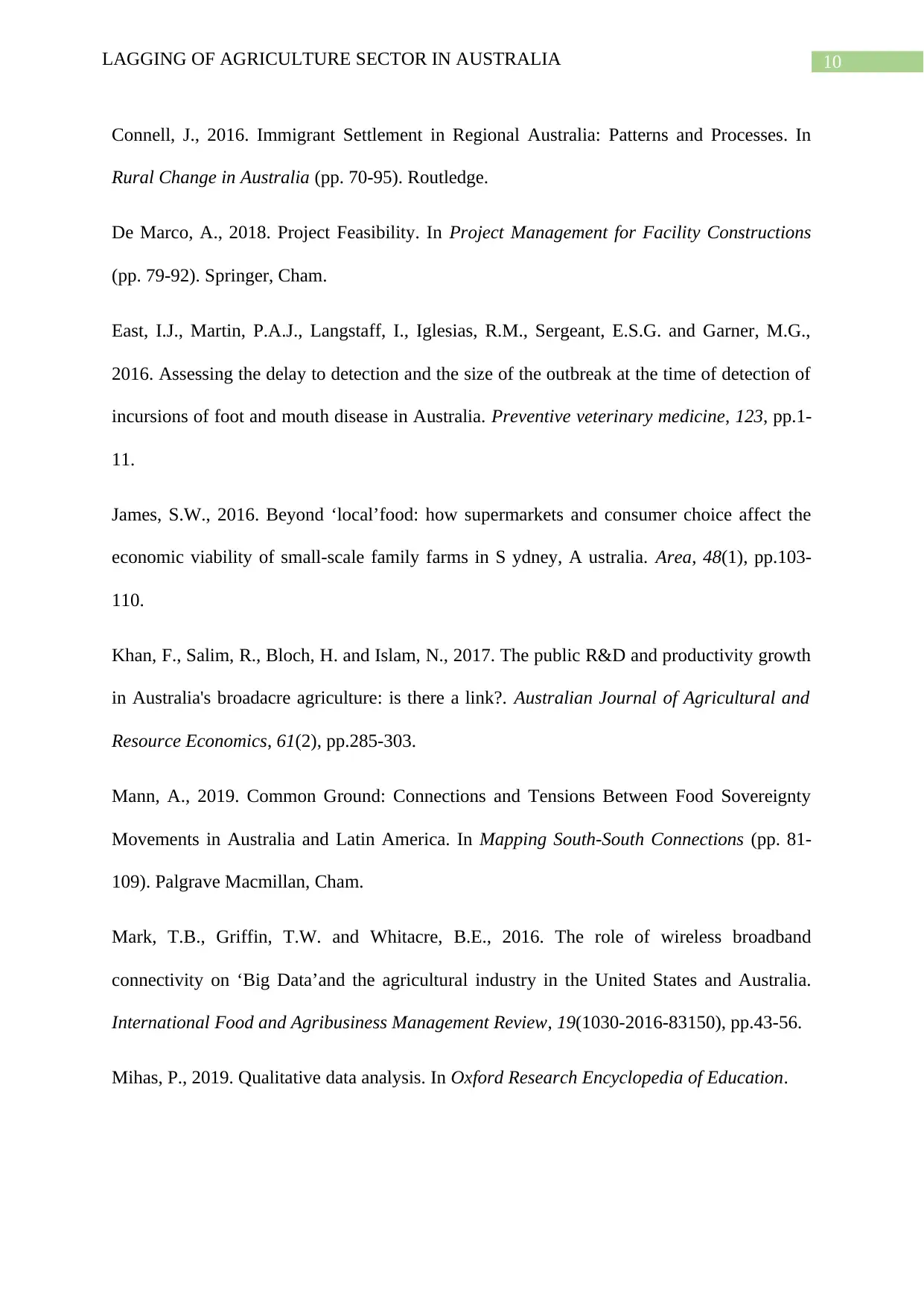
10LAGGING OF AGRICULTURE SECTOR IN AUSTRALIA
Connell, J., 2016. Immigrant Settlement in Regional Australia: Patterns and Processes. In
Rural Change in Australia (pp. 70-95). Routledge.
De Marco, A., 2018. Project Feasibility. In Project Management for Facility Constructions
(pp. 79-92). Springer, Cham.
East, I.J., Martin, P.A.J., Langstaff, I., Iglesias, R.M., Sergeant, E.S.G. and Garner, M.G.,
2016. Assessing the delay to detection and the size of the outbreak at the time of detection of
incursions of foot and mouth disease in Australia. Preventive veterinary medicine, 123, pp.1-
11.
James, S.W., 2016. Beyond ‘local’food: how supermarkets and consumer choice affect the
economic viability of small‐scale family farms in S ydney, A ustralia. Area, 48(1), pp.103-
110.
Khan, F., Salim, R., Bloch, H. and Islam, N., 2017. The public R&D and productivity growth
in Australia's broadacre agriculture: is there a link?. Australian Journal of Agricultural and
Resource Economics, 61(2), pp.285-303.
Mann, A., 2019. Common Ground: Connections and Tensions Between Food Sovereignty
Movements in Australia and Latin America. In Mapping South-South Connections (pp. 81-
109). Palgrave Macmillan, Cham.
Mark, T.B., Griffin, T.W. and Whitacre, B.E., 2016. The role of wireless broadband
connectivity on ‘Big Data’and the agricultural industry in the United States and Australia.
International Food and Agribusiness Management Review, 19(1030-2016-83150), pp.43-56.
Mihas, P., 2019. Qualitative data analysis. In Oxford Research Encyclopedia of Education.
Connell, J., 2016. Immigrant Settlement in Regional Australia: Patterns and Processes. In
Rural Change in Australia (pp. 70-95). Routledge.
De Marco, A., 2018. Project Feasibility. In Project Management for Facility Constructions
(pp. 79-92). Springer, Cham.
East, I.J., Martin, P.A.J., Langstaff, I., Iglesias, R.M., Sergeant, E.S.G. and Garner, M.G.,
2016. Assessing the delay to detection and the size of the outbreak at the time of detection of
incursions of foot and mouth disease in Australia. Preventive veterinary medicine, 123, pp.1-
11.
James, S.W., 2016. Beyond ‘local’food: how supermarkets and consumer choice affect the
economic viability of small‐scale family farms in S ydney, A ustralia. Area, 48(1), pp.103-
110.
Khan, F., Salim, R., Bloch, H. and Islam, N., 2017. The public R&D and productivity growth
in Australia's broadacre agriculture: is there a link?. Australian Journal of Agricultural and
Resource Economics, 61(2), pp.285-303.
Mann, A., 2019. Common Ground: Connections and Tensions Between Food Sovereignty
Movements in Australia and Latin America. In Mapping South-South Connections (pp. 81-
109). Palgrave Macmillan, Cham.
Mark, T.B., Griffin, T.W. and Whitacre, B.E., 2016. The role of wireless broadband
connectivity on ‘Big Data’and the agricultural industry in the United States and Australia.
International Food and Agribusiness Management Review, 19(1030-2016-83150), pp.43-56.
Mihas, P., 2019. Qualitative data analysis. In Oxford Research Encyclopedia of Education.
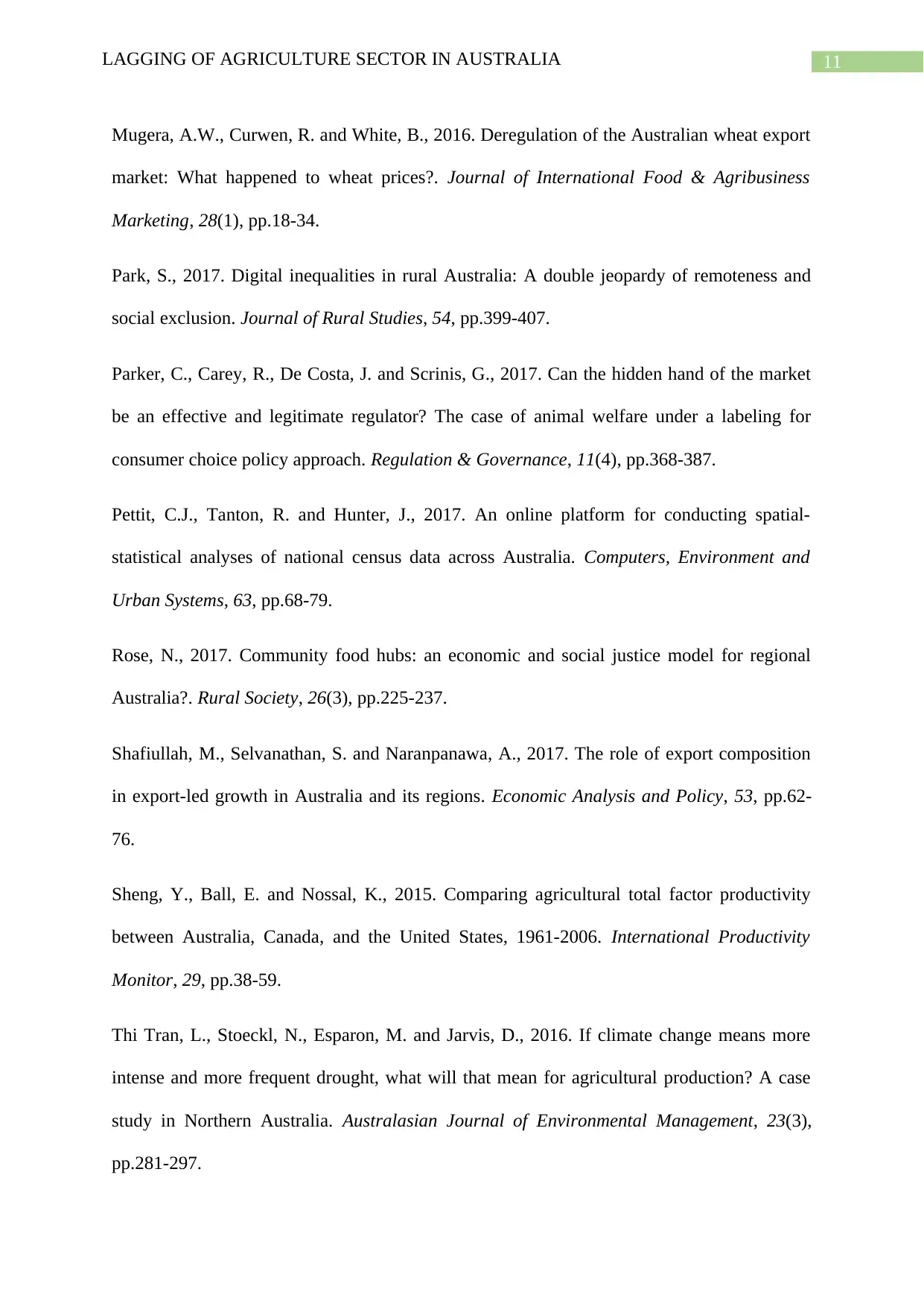
11LAGGING OF AGRICULTURE SECTOR IN AUSTRALIA
Mugera, A.W., Curwen, R. and White, B., 2016. Deregulation of the Australian wheat export
market: What happened to wheat prices?. Journal of International Food & Agribusiness
Marketing, 28(1), pp.18-34.
Park, S., 2017. Digital inequalities in rural Australia: A double jeopardy of remoteness and
social exclusion. Journal of Rural Studies, 54, pp.399-407.
Parker, C., Carey, R., De Costa, J. and Scrinis, G., 2017. Can the hidden hand of the market
be an effective and legitimate regulator? The case of animal welfare under a labeling for
consumer choice policy approach. Regulation & Governance, 11(4), pp.368-387.
Pettit, C.J., Tanton, R. and Hunter, J., 2017. An online platform for conducting spatial-
statistical analyses of national census data across Australia. Computers, Environment and
Urban Systems, 63, pp.68-79.
Rose, N., 2017. Community food hubs: an economic and social justice model for regional
Australia?. Rural Society, 26(3), pp.225-237.
Shafiullah, M., Selvanathan, S. and Naranpanawa, A., 2017. The role of export composition
in export-led growth in Australia and its regions. Economic Analysis and Policy, 53, pp.62-
76.
Sheng, Y., Ball, E. and Nossal, K., 2015. Comparing agricultural total factor productivity
between Australia, Canada, and the United States, 1961-2006. International Productivity
Monitor, 29, pp.38-59.
Thi Tran, L., Stoeckl, N., Esparon, M. and Jarvis, D., 2016. If climate change means more
intense and more frequent drought, what will that mean for agricultural production? A case
study in Northern Australia. Australasian Journal of Environmental Management, 23(3),
pp.281-297.
Mugera, A.W., Curwen, R. and White, B., 2016. Deregulation of the Australian wheat export
market: What happened to wheat prices?. Journal of International Food & Agribusiness
Marketing, 28(1), pp.18-34.
Park, S., 2017. Digital inequalities in rural Australia: A double jeopardy of remoteness and
social exclusion. Journal of Rural Studies, 54, pp.399-407.
Parker, C., Carey, R., De Costa, J. and Scrinis, G., 2017. Can the hidden hand of the market
be an effective and legitimate regulator? The case of animal welfare under a labeling for
consumer choice policy approach. Regulation & Governance, 11(4), pp.368-387.
Pettit, C.J., Tanton, R. and Hunter, J., 2017. An online platform for conducting spatial-
statistical analyses of national census data across Australia. Computers, Environment and
Urban Systems, 63, pp.68-79.
Rose, N., 2017. Community food hubs: an economic and social justice model for regional
Australia?. Rural Society, 26(3), pp.225-237.
Shafiullah, M., Selvanathan, S. and Naranpanawa, A., 2017. The role of export composition
in export-led growth in Australia and its regions. Economic Analysis and Policy, 53, pp.62-
76.
Sheng, Y., Ball, E. and Nossal, K., 2015. Comparing agricultural total factor productivity
between Australia, Canada, and the United States, 1961-2006. International Productivity
Monitor, 29, pp.38-59.
Thi Tran, L., Stoeckl, N., Esparon, M. and Jarvis, D., 2016. If climate change means more
intense and more frequent drought, what will that mean for agricultural production? A case
study in Northern Australia. Australasian Journal of Environmental Management, 23(3),
pp.281-297.
⊘ This is a preview!⊘
Do you want full access?
Subscribe today to unlock all pages.

Trusted by 1+ million students worldwide
1 out of 13
Related Documents
Your All-in-One AI-Powered Toolkit for Academic Success.
+13062052269
info@desklib.com
Available 24*7 on WhatsApp / Email
![[object Object]](/_next/static/media/star-bottom.7253800d.svg)
Unlock your academic potential
Copyright © 2020–2025 A2Z Services. All Rights Reserved. Developed and managed by ZUCOL.





